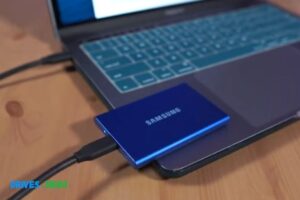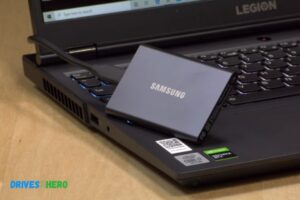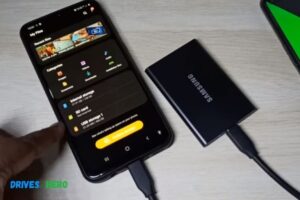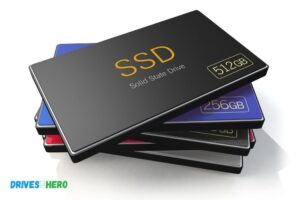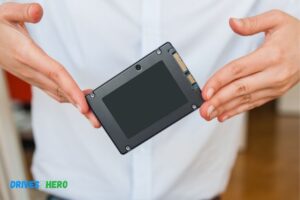No Samsung Portable Ssd is Connected Android: A Guide!
If no Samsung Portable SSD is connected to your Android device, it could be due to several reasons such as incompatible file formats, faulty USB cable or port, or outdated SSD Firmware.
Samsung Portable SSDs are designed to work seamlessly with Android devices. However, there are instances when the Samsung Portable SSD might not be recognized or connected to your Android device.
The main reasons for this could be due to the file formats not being compatible with your device, a faulty USB cable or port, outdated SSD Firmware, or issues with the SSD drive itself.
Connecting a Samsung Portable SSD to your Android device can greatly expand your storage and make data transfer a breeze.
However, if the SSD is not being recognized, your first steps should be checking the compatibility of the file formats, inspecting the USB cable and port, and updating the SSD Firmware.
Lastly, you might need to check the SSD drive itself for any potential issues. With these steps, you can effectively troubleshoot and resolve the issue.

Key Takeaway
Five Facts About Troubleshooting Samsung Portable SSD Not Connecting to Android
Common Causes Of Connectivity Issues
Connectivity issues with Samsung Portable SSD not connecting to Android devices can have several causes. These include cable or port problems, outdated device drivers, incompatible software, or settings issues.
Outdated Firmware Or Software On The Ssd:
- The SSD firmware or software may be outdated, which can hinder its compatibility with your Android device.
- Updating the firmware or software on your SSD can help resolve the connectivity problem.
- Visit the Samsung website and download the latest firmware or software update for your Samsung Portable SSD.
- Follow the provided instructions to install the update and ensure compatibility with your Android device.
Compatibility Issues With Android Device:
- Not all Android devices are compatible with Samsung Portable SSDs.
- Check the compatibility list on the Samsung website to ensure that your device is supported.
- Older Android versions may not have the necessary drivers to recognize and connect to the SSD.
- Consider upgrading your Android device to a compatible version if compatibility issues persist.
USB Connection Problems:
- The USB connection may be the culprit behind the connectivity issues.
- Check the USB cable for any damages or loose connections.
- Try using a different USB cable to rule out cable-related problems.
- Ensure that the USB port on your Android device is functioning properly.
- Clean the USB port to remove any debris or dust particles that may be affecting the connection.
- Connect the SSD directly to the Android device without using any additional USB hubs or extensions.
Remember, keeping your Samsung Portable SSD firmware or software up to date, checking for compatibility with your Android device, and troubleshooting USB connection problems are essential steps in resolving connectivity issues.
By following these guidelines, you can ensure a seamless and hassle-free connection between your Samsung Portable SSD and Android device.
Troubleshooting Steps To Fix The Issue
Check For Software Updates On The Ssd And Android Device
To ensure that there are no compatibility issues, it is essential to check for software updates on both your Samsung Portable SSD and Android device.
Follow these steps:
- Connect your SSD to the computer and check for any available updates through the manufacturer’s official website or software.
- On your Android device, go to the settings menu and look for ‘Software Updates.’ If any updates are available, make sure to install them.
Verify USB Cable Is Working Properly
Sometimes, the issue may not lie with the SSD or the Android device, but rather with the USB cable being used.
Follow these steps to ensure that the USB cable is working properly:
- Check the USB cable for any visible damages such as frayed wires or bent connectors. If you find any issues, replace the cable with a new one.
- Try using a different USB cable to connect the Samsung Portable SSD to your Android device. This will help determine if the cable is the culprit.
Ensure USB debugging Is Enabled On The Android Device
USB debugging allows your Android device to communicate with other devices, such as the Samsung Portable SSD.
Follow these steps to enable USB debugging:
- Go to the settings menu on your Android device and navigate to ‘Developer options.’
- If ‘Developer options’ are not visible, go to ‘About phone/tablet’ and tap on the ‘Build number’ multiple times until a message appears indicating that you are now a developer.
- Once in ‘Developer options,’ look for ‘USB debugging’ and enable it.
By following these troubleshooting steps, you should be able to resolve the issue of your Samsung Portable SSD not connecting to your Android device.
Downloading And Installing The Samsung Portable Ssd Software
To download and install the Samsung Portable SSD software on your Android device, you need to ensure that the SSD is connected properly.
Follow the instructions provided by Samsung to establish the connection and access the software for your device.
Visit The Official Samsung Website:
- Open your preferred web browser and visit the official Samsung website.
- Look for the “Support” or “Downloads” section on the website.
- Enter the model number or name of your Samsung Portable SSD in the search bar and hit Enter.
- Locate the software download page for your specific SSD model.
Locate And Download The Ssd Software For Android:
To connect your Samsung portable SSD to your Android device, you’ll need to download the appropriate software.
Here’s how you can find and download the software:
- On the SSD software download page, scroll down and find the software version compatible with Android devices.
- Click on the download link next to the Android version of the software.
- Wait for the download to complete.
Install The Software On Your Device:
Now that you have successfully downloaded the Samsung Portable SSD software for Android, it’s time to install it on your device.
Follow these steps:
- Open the file manager on your Android device.
- Locate the downloaded software file (usually found in the “Downloads” folder).
- Tap on the software file to start the installation process.
- Follow the on-screen instructions to complete the installation.
Once the installation is complete, you should be able to connect your Samsung portable SSD to your Android device without any issues. Enjoy the convenience of accessing your files on the go!
Updating The Firmware On Samsung Portable Ssd
To update the firmware on your Samsung Portable SSD when the Android device shows no connection, follow these steps for a seamless process. Keep your SSD up-to-date for smooth performance and enhanced functionality.
Connect The Ssd To Your Android Device:
- Connect the Samsung portable SSD to your Android device using a compatible USB cable.
- Make sure the connection is secure to ensure a successful firmware update.
Open The Samsung Portable Ssd Software:
- Locate and open the Samsung Portable SSD software on your Android device.
- If you don’t have the software installed, visit the official Samsung website to download and install it.
Follow The Prompts To Check For And Install Firmware Updates:
- Once the Samsung Portable SSD software is open, look for the option to check for firmware updates.
- Click on “Check for Updates” or a similar prompt to initiate the firmware update process.
Ensure A Successful Firmware Update:
- The software will now search for any available firmware updates for your Samsung portable SSD.
- If an update is found, follow the on-screen prompts to proceed with the installation.
- Make sure your Android device remains connected to the SSD throughout the update process.
- Do not disconnect the SSD or interrupt the update until it is fully completed.
By following these steps, you can easily update the firmware on your Samsung portable SSD to address any connectivity issues with your Android device.
Keeping your SSD’s firmware up to date ensures optimal performance and compatibility. Stay connected and enjoy seamless data transfer with your Samsung portable SSD and Android device.
Checking System Requirements
Ensure your Android device is compatible with the Samsung Portable SSD by verifying the system requirements.
Review The Minimum System Requirements For The Ssd And Android Device:
To guarantee compatibility between your Samsung Portable SSD and Android device, consider the following:
- The SSD should be USB 3.2 Gen 2 (10 Gbps) or higher compatible, enabling faster data transfer and optimal performance.
- Your Android device must support the USB On-The-Go (OTG) function, allowing external devices like the SSD to connect seamlessly.
- Ensure your Android device runs on Android version 5.0 (Lollipop) or higher, providing support for the necessary software and drivers.
- Verify that your Android device has adequate storage space to accommodate the SSD’s software and any files you plan to transfer. Aim for at least a few gigabytes of free space.
By fulfilling these minimum system requirements, you can ensure compatibility between your Samsung Portable SSD and Android device, creating an efficient and reliable data transfer solution.
Remember, to make the most of your Samsung Portable SSD and its features, it is crucial to keep your Android device updated with the latest operating system version.
Troubleshooting Compatibility Issues
If you’re experiencing difficulties connecting your Samsung Portable SSD to your Android device, there are a few steps you can take to troubleshoot compatibility issues.
Below are some solutions that can help you get your SSD up and running:
Reset The SSD to Factory Settings:
- Press and hold the power button on your Samsung Portable SSD until the device turns off.
- Once the SSD is turned off, press and hold the power button again to turn it back on.
- This will reset the SSD to its factory settings, potentially resolving any software conflicts.
Clear Cache And Data From The Samsung Portable Ssd App:
- Go to your Android device’s Settings menu.
- Find the Apps or Applications section and locate the Samsung Portable SSD app.
- Tap on the app and then select Storage.
- Click on Clear Cache and Clear Data to remove any temporary files or corrupted data that may be causing compatibility issues.
Ensure All Necessary Drivers Are Installed On Your Android Device:
- Connect your Samsung Portable SSD to your Android device using the appropriate USB cable.
- Check if the SSD is recognized and if any prompts or notifications appear on your Android device.
- If there are no prompts or notifications, it may indicate that the necessary drivers are not installed.
- Visit the official Samsung website and search for the drivers specific to your Android device.
- Download and install the drivers, following the provided instructions.
- After installing the drivers, reconnect the SSD to your Android device to test if the compatibility issues have been resolved.
By following these troubleshooting steps, you can address compatibility issues with your Samsung Portable SSD and ensure it works seamlessly with your Android device.
FAQ On No Samsung Portable SSD Is Connected Android
How can I connect a Samsung Portable SSD to an Android device?
You cannot directly connect a Samsung Portable SSD to an Android device. However, you can transfer files to and from a Samsung Portable SSD using an Android device through a USB adapter or a micro USB card reader.
What type of adapter do I need to connect a Samsung Portable SSD to an Android device?
You will need to purchase a USB adapter or a micro USB card reader that is compatible with your Android device to connect a Samsung Portable SSD.
Is it possible to connect a Samsung Portable SSD to an iPhone or iPad?
No, it is not possible to connect a Samsung Portable SSD to an iPhone or iPad.
Does my Samsung Portable SSD need to be reformatted before I can use it on an Android device?
Yes, you will need to reformat your Samsung Portable SSD for use on an Android device before you can transfer files.
Is connecting a Samsung Portable SSD to an Android device safe?
Yes, as long as you are using an adapter or card reader that is compatible with your Android device, connecting a Samsung Portable SSD to an Android device is safe.
Conclusion
Troubleshooting the issue of a Samsung portable SSD not connecting to an Android device can be a frustrating experience, but there are several steps you can take to resolve the problem. First, ensure that the cables and connections are secure and in good condition.
Next, check that the SSD is compatible with your Android device and that the necessary drivers are installed. If these steps do not work, try connecting the SSD to a different USB port or using a different USB cable.
You can also try connecting the SSD to a different Android device to rule out any issues with your original device. If all else fails, contacting Samsung support or seeking professional assistance may be necessary.
Remember, troubleshooting these types of technical issues requires patience and persistence, but with the right approach, you can get your Samsung portable SSD connected to your Android device smoothly.

